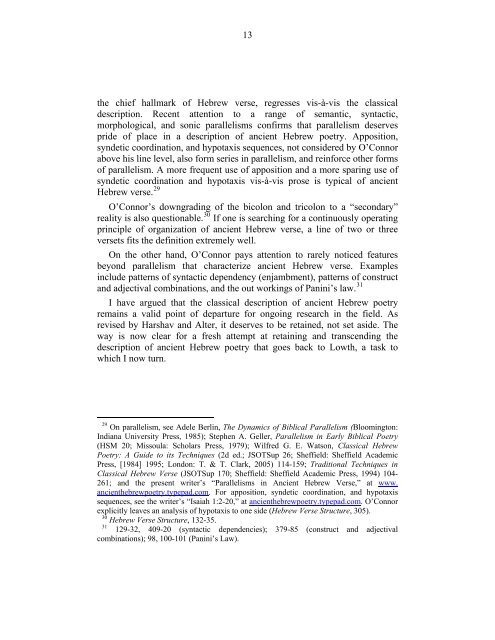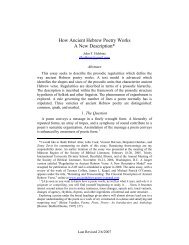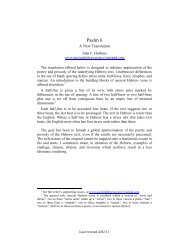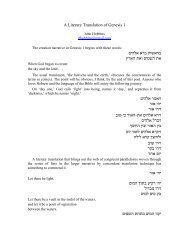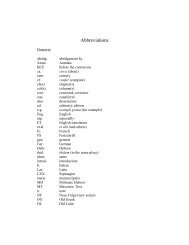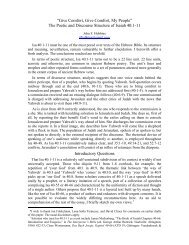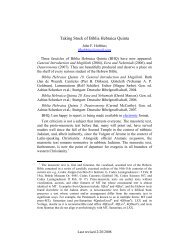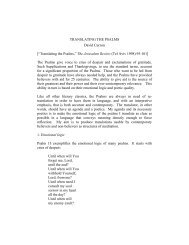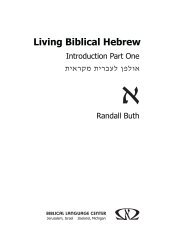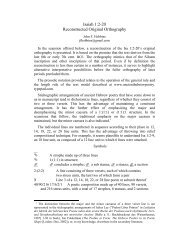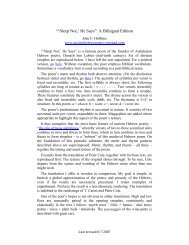Here - Ancient Hebrew Poetry - Typepad
Here - Ancient Hebrew Poetry - Typepad
Here - Ancient Hebrew Poetry - Typepad
- No tags were found...
Create successful ePaper yourself
Turn your PDF publications into a flip-book with our unique Google optimized e-Paper software.
13the chief hallmark of <strong>Hebrew</strong> verse, regresses vis-à-vis the classicaldescription. Recent attention to a range of semantic, syntactic,morphological, and sonic parallelisms confirms that parallelism deservespride of place in a description of ancient <strong>Hebrew</strong> poetry. Apposition,syndetic coordination, and hypotaxis sequences, not considered by O’Connorabove his line level, also form series in parallelism, and reinforce other formsof parallelism. A more frequent use of apposition and a more sparing use ofsyndetic coordination and hypotaxis vis-à-vis prose is typical of ancient<strong>Hebrew</strong> verse. 29O’Connor’s downgrading of the bicolon and tricolon to a “secondary”reality is also questionable. 30 If one is searching for a continuously operatingprinciple of organization of ancient <strong>Hebrew</strong> verse, a line of two or threeversets fits the definition extremely well.On the other hand, O’Connor pays attention to rarely noticed featuresbeyond parallelism that characterize ancient <strong>Hebrew</strong> verse. Examplesinclude patterns of syntactic dependency (enjambment), patterns of constructand adjectival combinations, and the out workings of Panini’s law. 31I have argued that the classical description of ancient <strong>Hebrew</strong> poetryremains a valid point of departure for ongoing research in the field. Asrevised by Harshav and Alter, it deserves to be retained, not set aside. Theway is now clear for a fresh attempt at retaining and transcending thedescription of ancient <strong>Hebrew</strong> poetry that goes back to Lowth, a task towhich I now turn.29 On parallelism, see Adele Berlin, The Dynamics of Biblical Parallelism (Bloomington:Indiana University Press, 1985); Stephen A. Geller, Parallelism in Early Biblical <strong>Poetry</strong>(HSM 20; Missoula: Scholars Press, 1979); Wilfred G. E. Watson, Classical <strong>Hebrew</strong><strong>Poetry</strong>: A Guide to its Techniques (2d ed.; JSOTSup 26; Sheffield: Sheffield AcademicPress, [1984] 1995; London: T. & T. Clark, 2005) 114-159; Traditional Techniques inClassical <strong>Hebrew</strong> Verse (JSOTSup 170; Sheffield: Sheffield Academic Press, 1994) 104-261; and the present writer’s “Parallelisms in <strong>Ancient</strong> <strong>Hebrew</strong> Verse,” at www.ancienthebrewpoetry.typepad.com. For apposition, syndetic coordination, and hypotaxissequences, see the writer’s “Isaiah 1:2-20,” at ancienthebrewpoetry.typepad.com. O’Connorexplicitly leaves an analysis of hypotaxis to one side (<strong>Hebrew</strong> Verse Structure, 305).30 <strong>Hebrew</strong> Verse Structure, 132-35.31129-32, 409-20 (syntactic dependencies); 379-85 (construct and adjectivalcombinations); 98, 100-101 (Panini’s Law).


